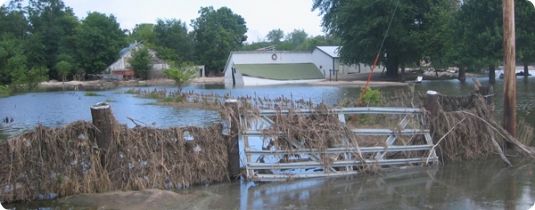The Best Defense: Disaster Preparedness

With extreme weather featuring more frequently in recent news, communities around the US are thinking about disaster preparedness. Families, businesses, churches and organizations can all be affected by disaster, and the best way to minimize damage is to have a plan in place.
One community that has taken this to heart is the Episcopal Diocese of Southwestern Virginia. In 2008 their annual council passed a resolution requiring all diocesan staff, parishes, missions and institutions to have up-to-date disaster preparedness plans. According to Bill Lindsay, the diocese’s Program Coordinator for Disaster Preparedness, the preparedness program was initiated by Bishop Neff Powell soon after the September 11 attacks, and diocesan staff have encouraged it ever since.
Lindsay has travelled around the diocese to assist parishes that have requested help with planning, and has made sure that he has one point of contact in each parish. To his knowledge, 12 parishes have created disaster preparedness plans, and two more are in the process.
One thing Lindsay mentioned is that many churches starting the planning process are worried about not having special skills like emergency first aid and triage. In such a situation, Lindsay’s advice is that the most important thing is for people to be committed and willing to work. Not everyone is an expert first responder, but all who are willing can contribute in their own way.
Katie Mears, Episcopal Relief & Development’s Program Manager for USA Disaster Preparedness and Response, agrees with Lindsay. “Our strength as a church is not necessarily as first responders,” she said. “These skills are highly valuable, but so are all sorts of community ministry experiences. A diversity of voices will help a parish build a successful preparedness and response plan.” For information and resources on parish disaster planning, including those Lindsay and his team developed, please visit the USA Disaster Preparedness and Response Resource Library.
Sharon Tillman, Director of Communications for the Diocese of Maryland, recently brought together a group with diverse experiences to discuss the creation of a disaster planning and response committee in her diocese. The group included parish nurses, a chaplain with experience after 9/11, a Baltimore police officer, a fire marshal and a grant writer. Tillman says her role was to convene the group and to contribute her specific knowledge. “I’m not a disaster professional,” she said. “I’m a communications professional, and that’s how I will help.”
“I think both of these dioceses are great reminders that disasters happen in all parts of the country, and all churches, no matter the size or location, should be prepared to respond,” Mears said.
Episcopal Relief & Development works with dioceses around the country to guide and assist them through all phases of emergency management, from preparedness to response and recovery.
The Disaster Preparedness Initiative is a growing area of the organization’s US-based work. By building a national volunteer database and holding local and regional trainings for emergency planners and responders, they are equipping their partners to help local communities in times of disaster. Episcopal Relief & Development assists dioceses with regional planning and coordination, in case of severe or widespread hardship. The agency also maintains a resource library to facilitate the sharing of information and best practices throughout the Church.
When a disaster strikes, Episcopal Relief & Development’s program staff contact local diocesan partners and help assess what kind of emergency assistance would be most useful. The diocesan leaders have access to the organization’s volunteer database, which catalogs Episcopalians interested in disaster response and is searchable by proximity and skill set. In addition, Episcopal Relief & Development’s Emergency Relief Program provides technical resources and can help connect leaders in affected areas to peers who have faced similar challenges. In some cases, emergency financial assistance is provided through a local Diocesan Emergency/Response Coordinator in order to meet the basic material needs of those affected – for example, in recent crises, utility assistance, temporary shelter and food have been provided.
In most cases, emergency relief programs are planned and completed within a few months following a disaster. Sometimes, though, a disaster’s magnitude warrants continued financial assistance from Episcopal Relief & Development’s Disaster Recovery Program. In these cases, the agency works with local partners to help vulnerable community members make a full and sustained recovery. Such programs currently address ongoing needs in North Dakota, where flooding caused severe damage to homes and buildings, and in areas of the Gulf Coast affected by hurricanes Ike and Katrina.
The US government has declared September to be National Disaster Preparedness Month, making it the perfect time to start or revise your plan. Individuals and congregations with questions about emergency planning and response are invited to browse the relevant pages on the Episcopal Relief & Development website. You can also become part of the response by signing up on the volunteer database, or making a contribution to the USA Disaster Response fund.


